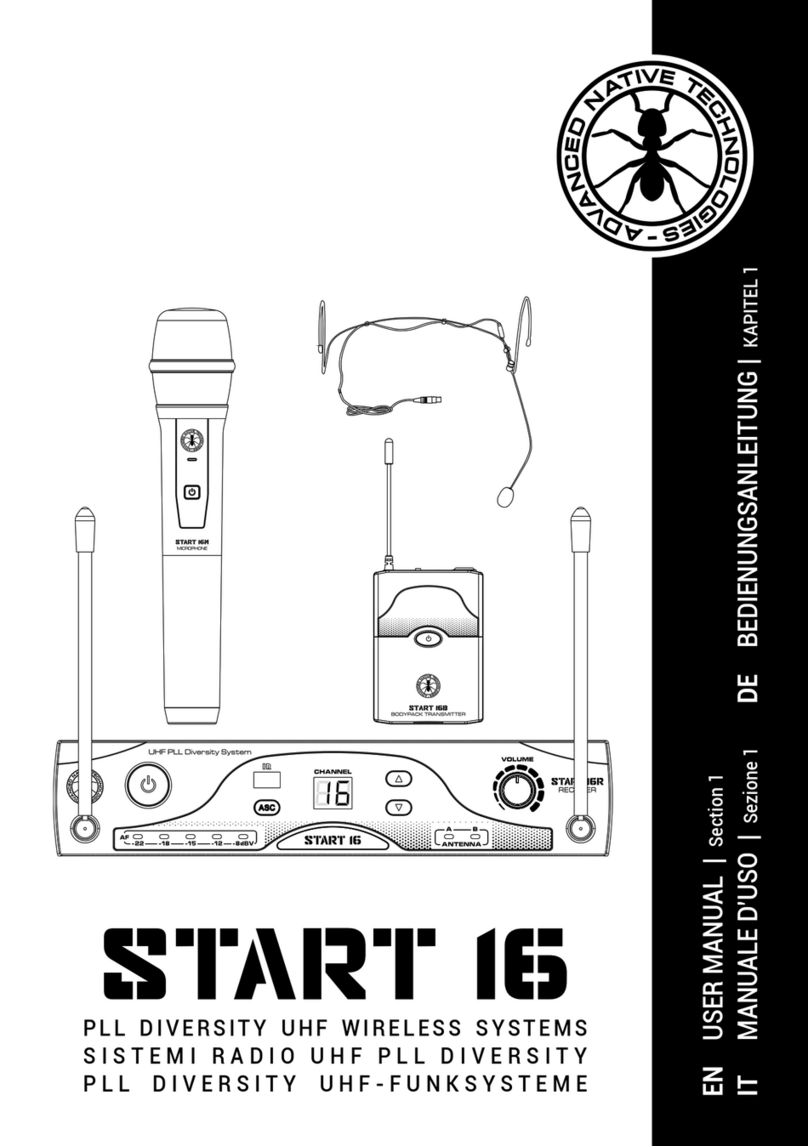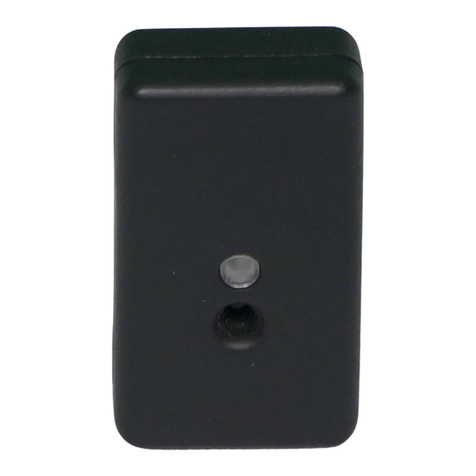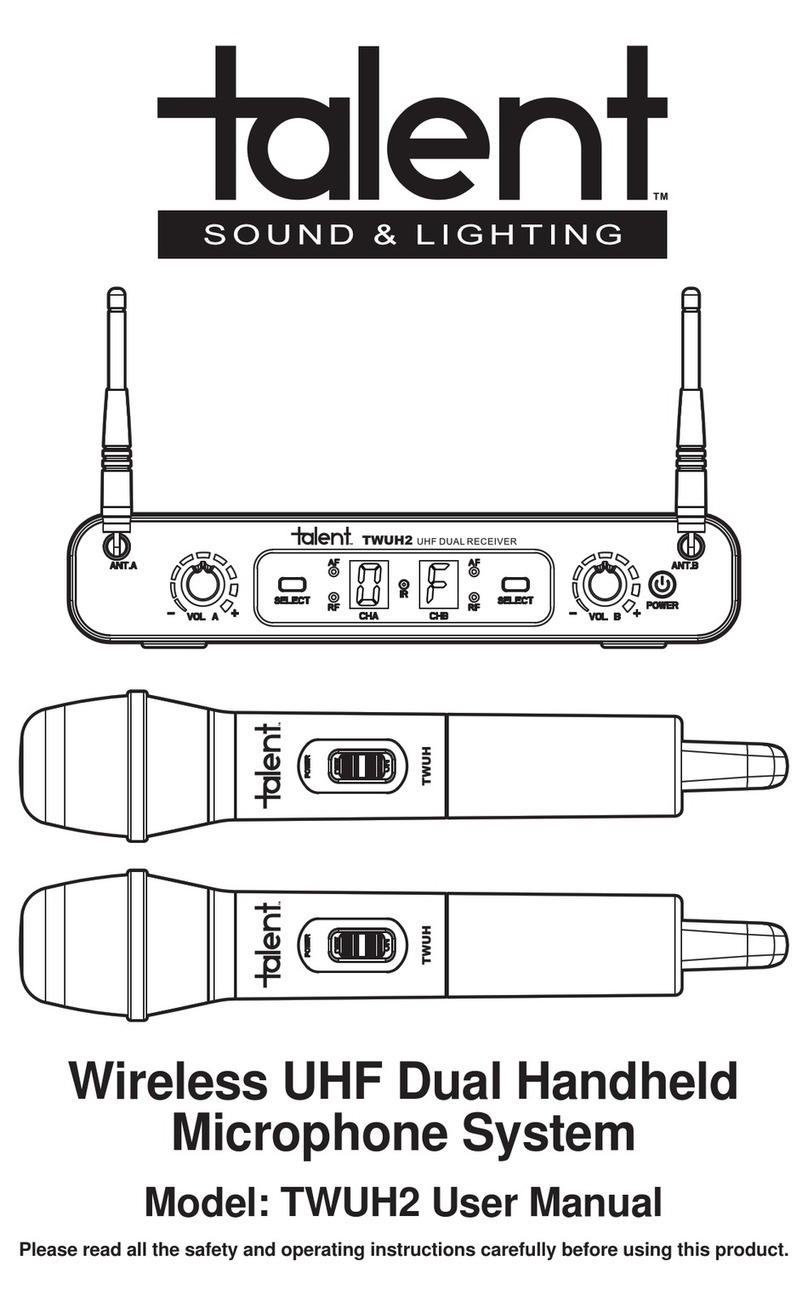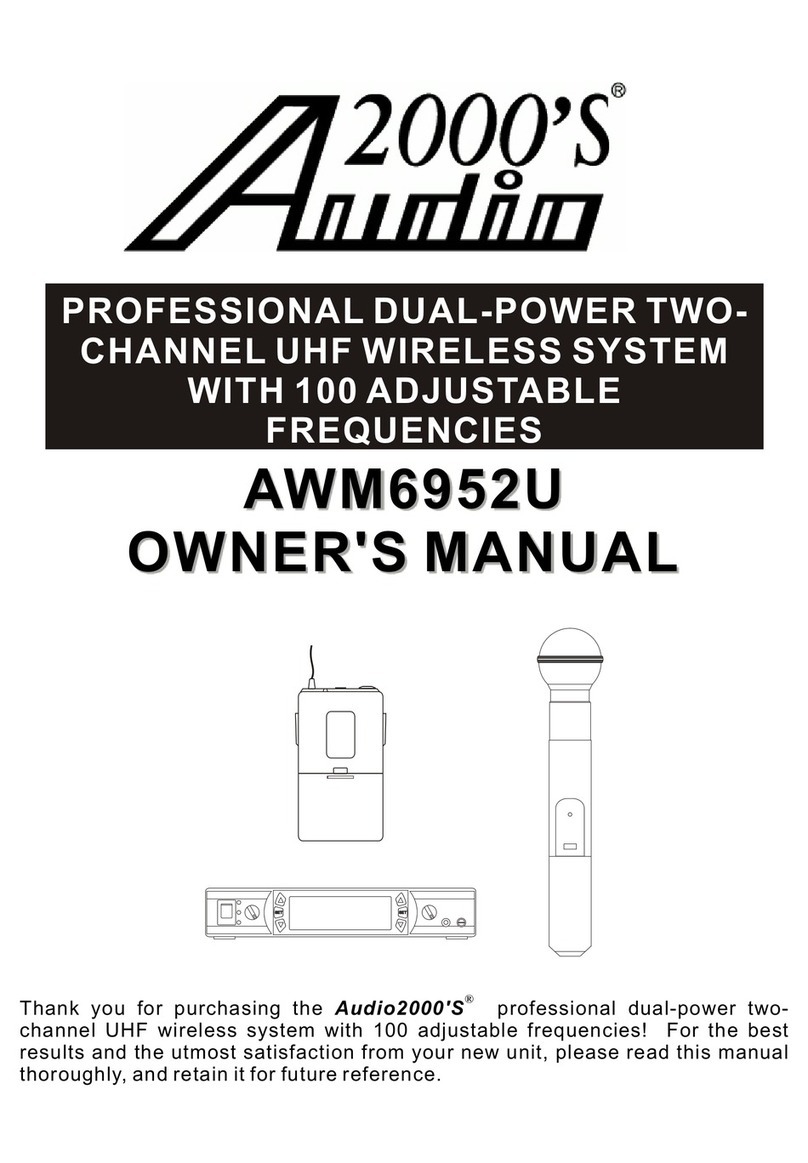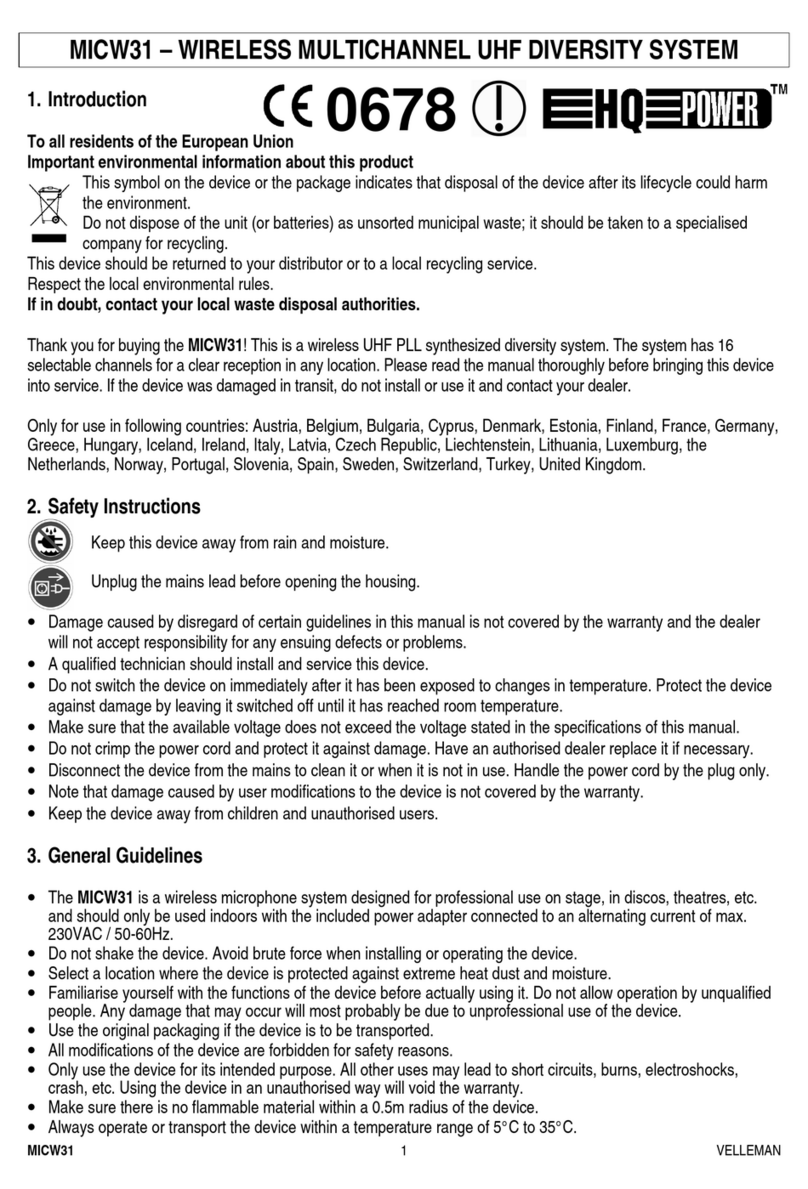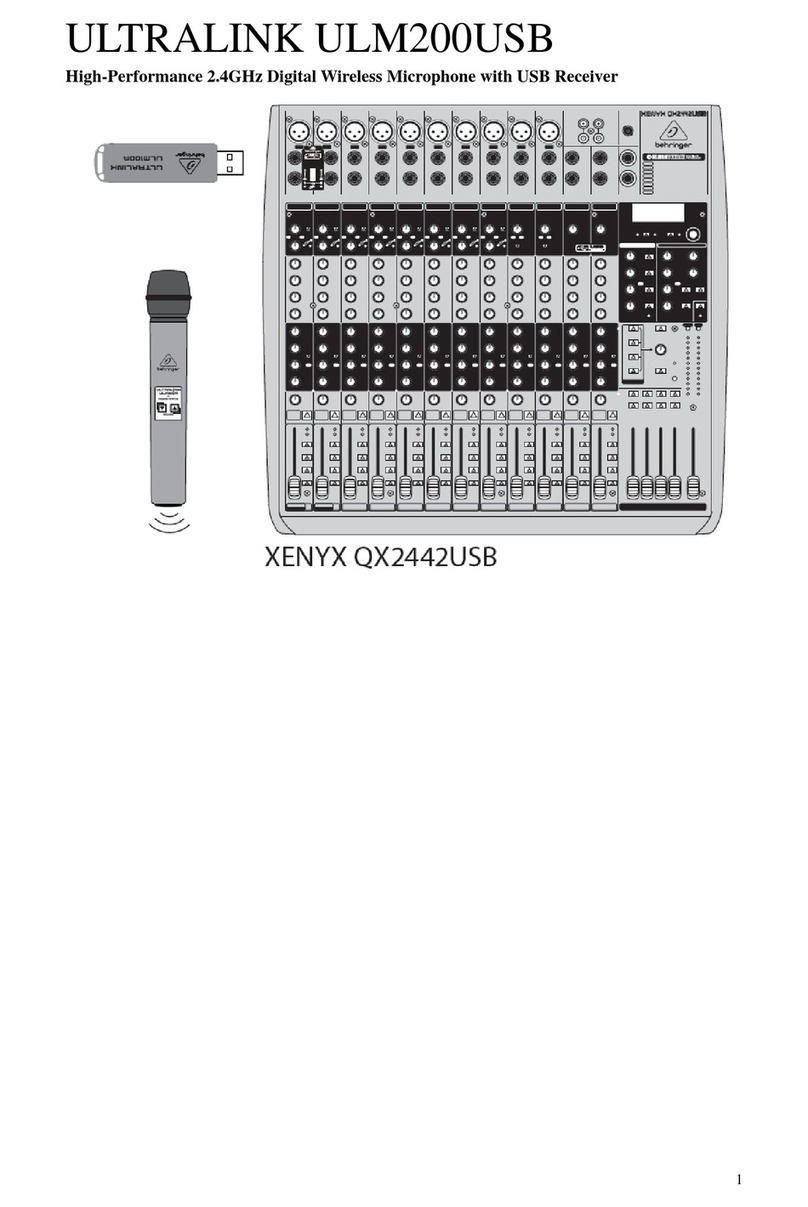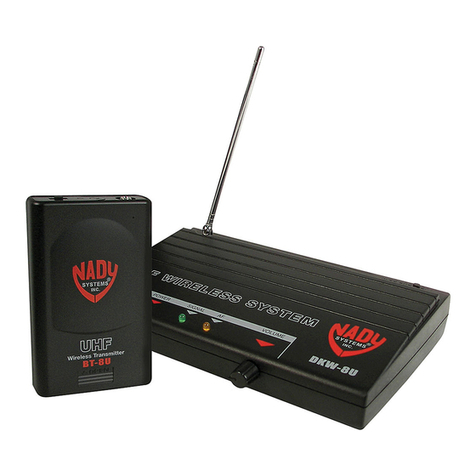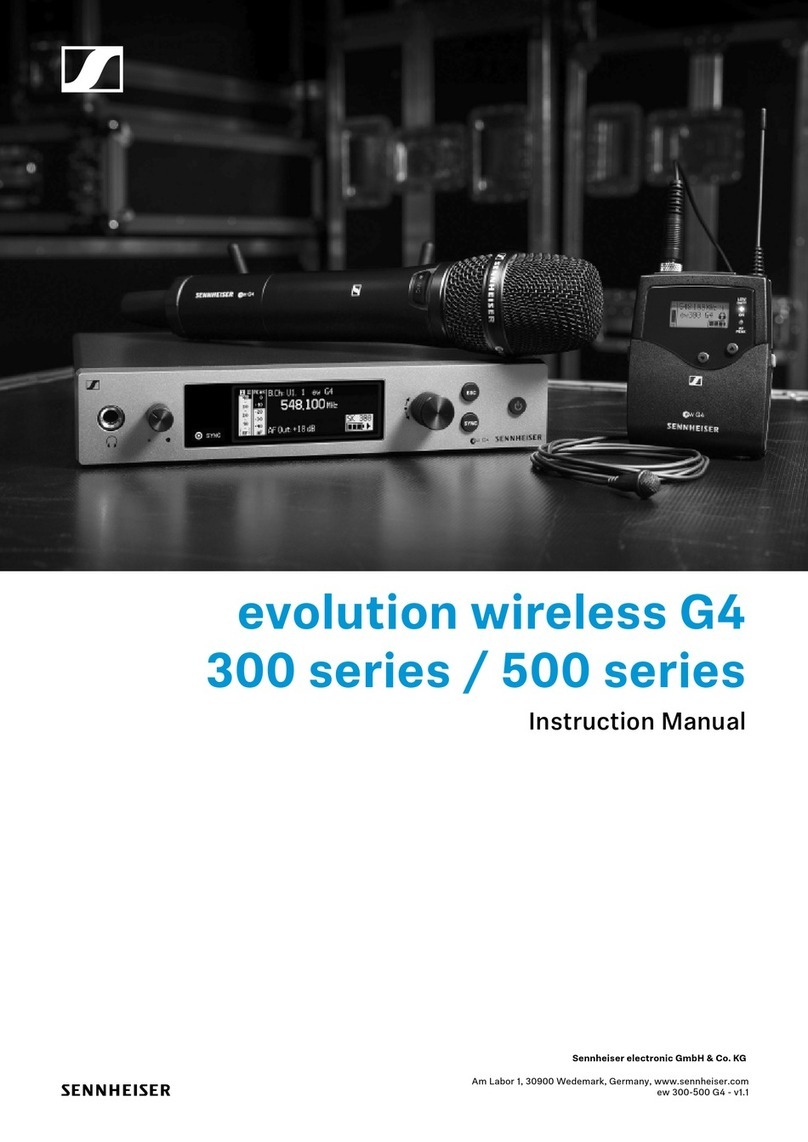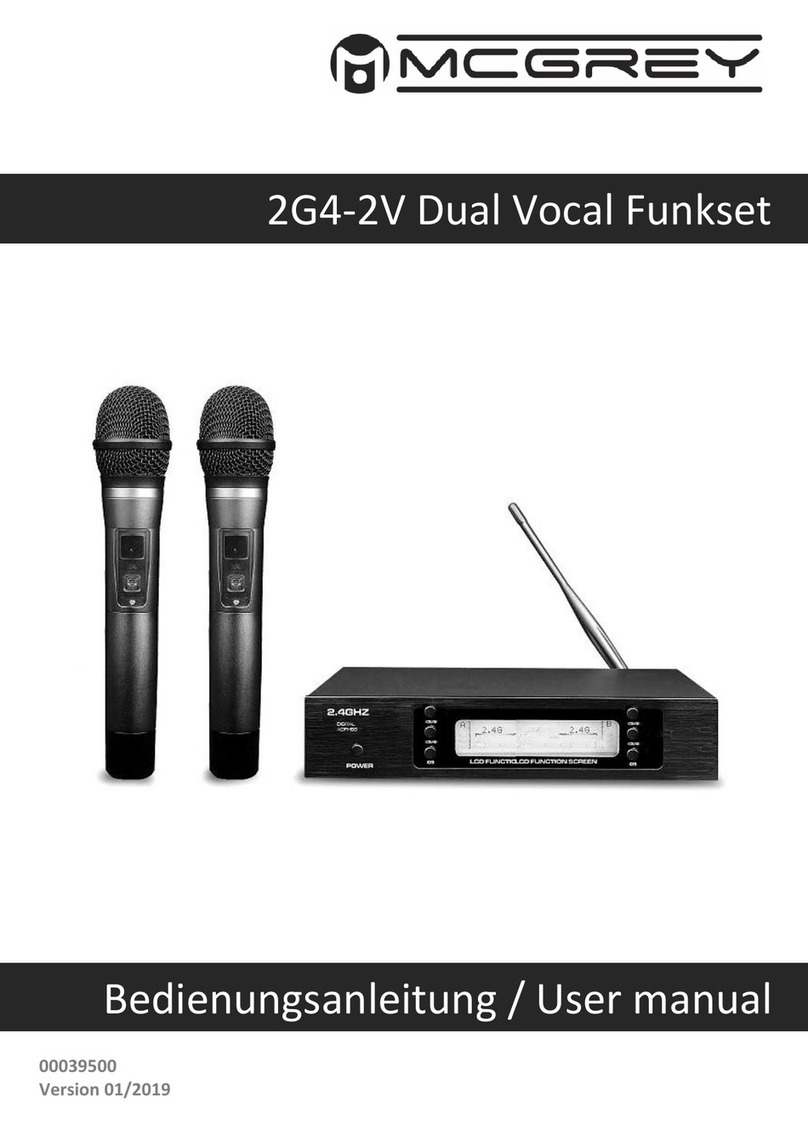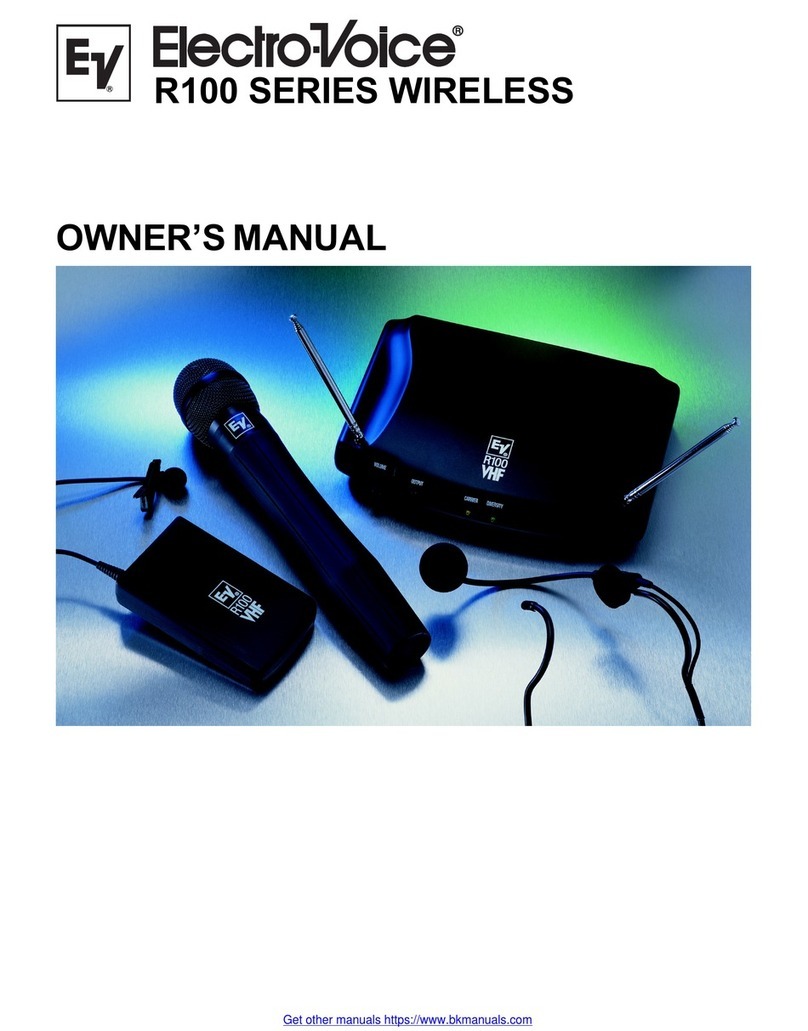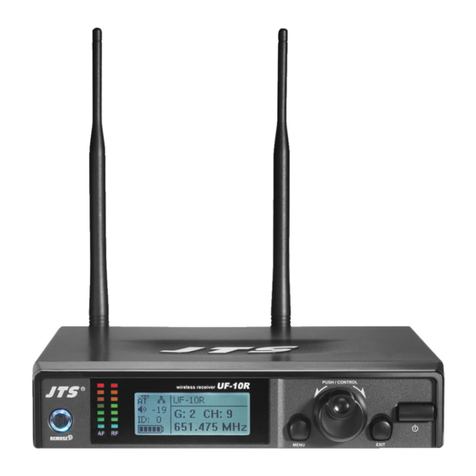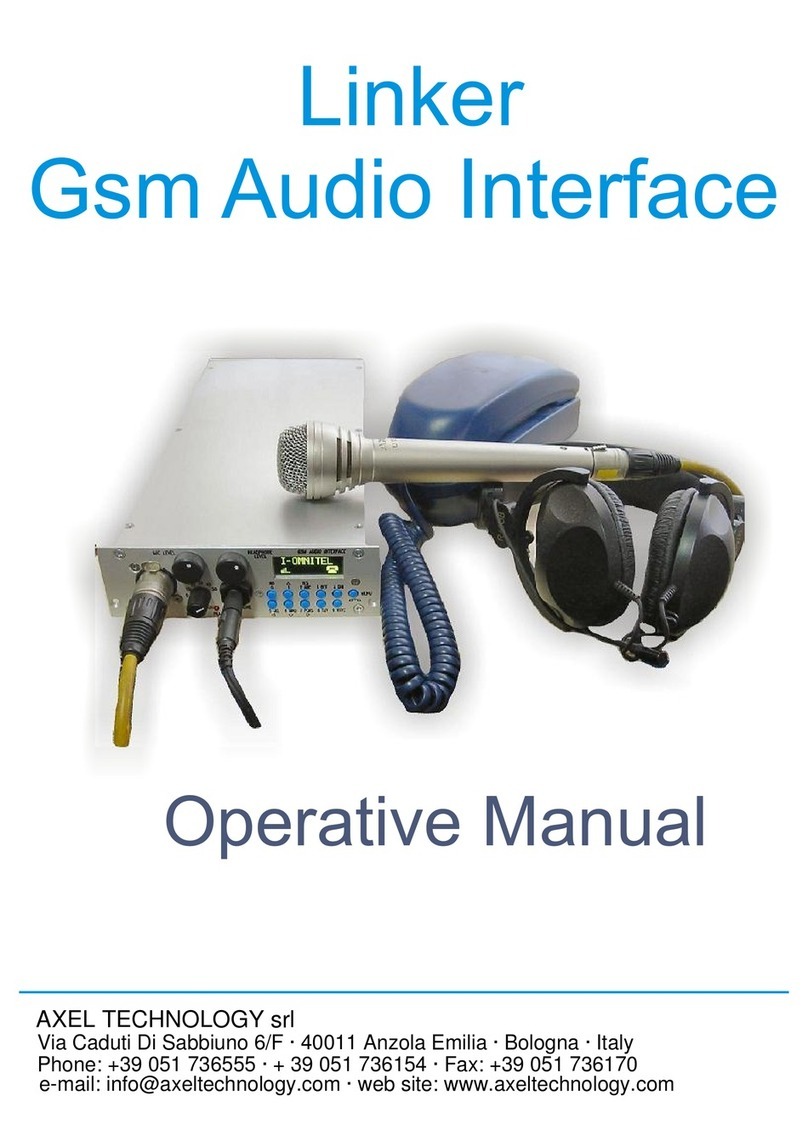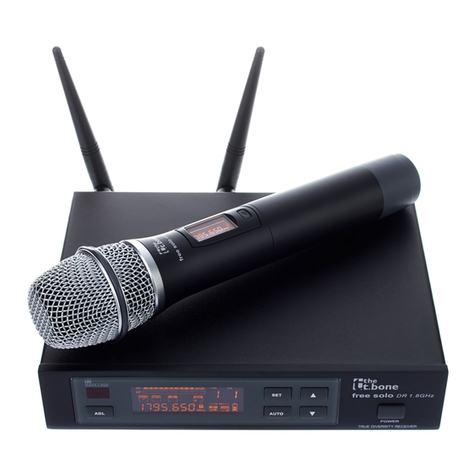Advanced Native Technologies START 16 Series User manual

PLL DIVERSITY UHF WIRELESS SYSTEMS
SISTEMI RADIO UHF PLL DIVERSITY
EN USER MANUAL | Section 1
IT MANUALE D’USO | Sezione 1
ES MANUAL DE USO | Sección 1
DE BEDIENUNGSANLEITUNG | Abschnitt 1
FR NOTICE D’EMPLOI | Section 1

2
User manual | START 16 Series
Series
CONTENTS
1| Introduction 4
2| Description 4
2.1 | Receiver 5
2.2 | Handheld microphone 6
2.3 | Beltpack transmitter 7
3| Tips to better use the system 8
4| Troubleshooting 9
5| Technical specications 10
6| Notes 52
A
E
G
B
F
D
C

ENGLISH
START 16 Series | User manual
3
The warnings in this manual must be observed together with
the “User manual - Section 2”.
PACKAGE CONTENT
START 16 HDM
Version with Handheld mic
• 1x START 16R receiver with built-in antennas - A
• 1x START 16Mw handheld dynamic microphone - B
• 1x External power adapter - C
• 1x Unbalanced 6,35mm (1/4”) jack audio cable - D
• 2x 1.5 Volts AA batteries - E
• 1x User manual - Section 1
• 1x User manual - Section 2
START 16 BHS
Version with Beltpack Transmitter and Headset mic
• 1x START 16R receiver with built-in antennas - A
• 1x START 16B beltpack transmitter with built-in anten
na - F
• 1x PH-90 ergonomic headset microphone - G
• 1x External power adapter - C
• 1x Unbalanced 6,35mm (1/4”) jack audio cable - D
• 2x 1.5 Volts AA batteries - E
• 1x User manual - Section 1
• 1x User manual - Section 2

4
User manual | START 16 Series
Series
1| INTRODUCTION
Thank you for choosing a A.N.T – Advanced Native Technologies – product!
In our START 16 “PLL Diversity” wireless systems we have put our passion and
our technological background gained over the years, to offer products that meet
your needs, maintaining the quality over time.
START 16 wireless systems operate in UHF band with 16 channels (frequencies).
You may choose the operating frequency via buttons or via infrared using ASC
feature.
Both versions of START 16R receivers adopt Diversity technology. They are
equipped with two discrete antennas A and B, which are used to select at any
moment the best radio signal. The antennas are fixed on the front panel of the
receiver, but may be placed in an horizontal position by means of a junction
present at their base.
Please,dedicatesomeminutestoreadthisinstructionmanualinordertoquicklyachieve
the best performances from this product.
For safety precautions, warranty and disposal, please refer to attached Section 2.
For further information about all A.N.T products catalog, please visit our website:
www.ant-sound.com
2| DESCRIPTION
1 2 3 74 65 8 9 10
FRONT PANEL
11

ENGLISH
START 16 Series | User manual
5
2.1 | RECEIVER - START 16R
1 POWER
Press this button on receiver front panel for 1” to turn ON/OFF the unit.
2 AF LEVEL METER
It shows the audio signal level. Avoid that the red LED (the rightmost one)
remains lit continuously.
3 ASC
Pressthisbuttontoachieveautomaticchannel(frequency)synchronization
via infrared.
4 IR WINDOW
Itallowsthesynchronizationofthechannel(frequency)withthetransmitter.
After pressing the ASC button, place the handheld microphone or beltpack
transmitter close to this window and wait for the selected channel to stop
flashing on the display. After the synchronization, the receiver’s display
islit steadily on the selected channel (frequency).
5 DISPLAY
It shows the number of the activated channel.
6 UP
Press this button to scroll and select channel number in ascending mode
from 01 to 16.
7 DOWN
Press this button to scroll and select channel number in descending mode
from 16 to 01.
8 ANTENNA A
This LED turns on automatically when the unit is receiving a better signal
from the antenna A.
9 ANTENNA B
This LED turns on automatically when the unit is receiving a better signal
from the antenna B.
10 VOLUME
It adjusts the output audio level.
11 ANTENNAS
Forthebestsignalreception,pleaseplacetheantennas in a vertical position.

6
User manual | START 16 Series
Series
21 3
REAR PANEL
1“DC 12-18V” POWER SOCKET
Connect to this socket only the supplied power supply.
2UNBAL
Unbalanced audio output with 6,35mm (1/4”) jack. Connect this output into an
unbalanced input of your mixer.
3AF OUTPUT
Balanced audio output with XLR-M socket. Connect this outputinto a balanced input
of your mixer.
1 GRILLE
It protects the microphone capsule from impacts and/or accidental falls and
itreduces the noise of the plosive.
2.2 | HANDHELD WIRELESS MICROPHONE - START 16M
21 3 4 5

ENGLISH
START 16 Series | User manual
7
2.3 | BELTPACK TRANSMITTER - START 16B
23 7 54 6
11 ANTENNA
It allows the transmission of the
signal.
2 ON/OFF
Pressthisbuttonfor3”toturnON
or OFF the beltpack transmitter.
3 IR WINDOW
It allows the synchronization of
the channel (frequency) with the
receiver.
After pressing the ASC button,
place the beltpack transmitter
close to the IR window of START
16R receiver and wait for the
selectedchanneltostopflashing
on the handset display. After
2 POWER ON AND BATTERY STATUS INDICATOR
GREEN: Transmitter activated (ON), charged batteries.
RED: Immediately replace the batteries.
WARNING: battery life is about 8 hours, but it may vary according to the
usage conditions.
3 ON/OFF
Press this button for 3” to turn on or off the wireless handheldmicrophone.
4 BATTERIES COMPARTMENT
Toaccessthebatterycompartmentunscrewthelidcounterclockwise,and
screw the lid clockwise to close it. Remove the batteries from the receiver
when not in use for extended periods.
5 IR WINDOW
It allows the synchronization of the channel (frequency) with the receiver.
AfterpressingtheASCbutton,placethebottomofthewirelessmicrophone
close to the IR window of START 16R receiver and wait for the selected
channeltostopflashingonthehandhelddisplay.Afterthesynchronization,
the receiver’s display is lit steadily on the selected channel (frequency).

8
User manual | START 16 Series
Series
the synchronization, the receiver’s display is lit steadily on the selected channel
(frequency).
4 MINI XLR-M INPUT
Connected to this input the supplied PH-90 Headset or the signal of other sound
sources.
5 POWER ON AND BATTERY STATUS INDICATOR
GREEN: Transmitter activated (ON), charged batteries.
RED: Immediately replace the batteries.
6 GAIN SELECTOR
There are three different gain settings:
Mic: for supplied headset microphone and other microphones
0 dB: low output level instruments
-10dB: high output level instruments
7 BATTERIES COMPARTMENT
To replace the batteries, lightly press on the sides of the cover and lift forward. Take
out the old batteries, and insert two new batteries (respecting the compartment
icons) then close the lid. Remove the batteries from the receiver when not in use
for extended periods.
WEARING THE BELTPACK RECEIVER:
Clip the receiver to a belt or to the
shoulder strap of your guitar. For better
fastening reliability it’s preferable to
secure it as shown in the gure, then
fasten it in a way that the belt is tight
from the clip.
3| TIPS FOR BETTER USE OF THE SYSTEM
• Aim the transmitter to the receiver to achieve a “direct visual contact” between
devices, without any interposed obstacle.
• Avoid placing the receiver near metal objects/surfaces or close to digital equipment
(CD players, computers, etc.).

ENGLISH
START 16 Series | User manual
9
• Place the receiver in such a way that is far from a wall and that is at least
1 meter (about 3 feet) above the floor.
• Cell phones, two-way radio equipment or similar devices may disturb
the radio transmission between the transmitter and the receiver, so they
should not be used close to the transmission system.
4| TROUBLESHOOTING
PROBLEM LEDS SOLUTION
No sound or very
low sound level. Receiver ON/OFF
LED turned off. Make sure the unit is properly
connected.
Power LED turned off. Make sure the power supply is
properly connected to the receiver.
Receiver RF LED turned on.
Raise the volume.
Raise gain on transmitter.
Check the connections between
receiver and amplier or mixer.
Receiver RF LED turned on.
Transmitter LED turned on.
Don’t place the receiver close to
metallic objects.
Check that the transmission
space (“visual contact”) between
transmitter and receiver is free.
Approached the transmitter to the
receiver.
Make sure the transmitter and
receiver share the same frequency.
Batteries status LED is red. Replace batteries.
Distortion or unwanted
interferences. Receiver RF LED
turned on.
Remove possible sources of
interference such as CD players,
computers, digital broadcast
sources, etc.
Increasing distortions.
Batteries status
LED is red. Replace batteries.
Great intensity difference
when the same source
is via cable, or in case of
connection with other
guitars or microphones.
Set properly the transmitter gain
selector and the receiver volume.

10
User manual | START 16 Series
Series
5| TECHNICAL SPECIFICATIONS
RECEIVER - START 16R
Type Diversity
Modulation FM
Available frequency bands 823-832MHz (B6) / 863-865MHz (B7)
Channels 16
Antennas x 2, adjustable and xed on front panel
Frequency response 60Hz - 15.000Hz (±3dB)
Transmission optimisation Pilot tone
THD <1%
Audio outputs Balanced XLR, unbalanced 6,35mm (1/4”) jack
Balanced output level + 10dBu
Controls Power, channel up, channel down, ASC, volume
Indicators Channel number, antenna A/B, 5 LEDs level
Dimensions (W x H x D) 212 x 44 x 115 mm (8.34” x 4.52” x 1.73”)
Weight 400 g (0.4 oz.)
HANDHELD MICROPHONE - START 16M
Modulation FM
Available frequency bands 823-832MHz (B6) / 863-865MHz (B7)
Channels 16
Type Dynamic
Polarity Cardioid
Frequency response 60Hz - 15.000Hz (±3dB)
Output power 5.19mW
Controls ON/OFF
Indicators Power and battery status
Power supply 2 AA 1.5 Volts batteries
Operating time >10h with alkaline batteries
Length 254 mm (10”)
Max diameter 52.5 mm (2.06”)
Weight 250 g (0.25 oz)

ENGLISH
START 16 Series | User manual
11
BELTPACK TRANSMITTER - START 16B
Modulation FM
Available frequency bands 823-832MHz (B6) / 863-865MHz (B7)
Channels 16
Input DC powered Mini-XLR for PH-90 Headset
Frequency response 60Hz - 15.000Hz (±3dB)
Output power 5.19mW
Controls Gain (3 steps), ON / Standby / OFF
Indicators Power and battery status
Power supply 2 AA 1.5 Volts batteries
Operating time >10h with alkaline batteries
Dimensions (W x H x D) 64 x 90 x 23 mm (2.51” x 0.91” x 3.54”)
Weight 80 g (0.08 oz)

12
Manuale d’uso | Serie START 16
Serie
INDICE
1| Introduzione 14
2| Descrizione 14
2.1 | Ricevitore 15
2.2 | Radiomicrofono a mano 16
2.3 | Trasmettitore beltpack 17
3| Consigli per una migliore utilizzazione del sistema 18
4| Soluzione dei problemi 19
5| Dati tecnici 20
6| Note 52
A
E
G
B
F
D
C

ITALIANO
Serie START 16 | Manuale d’uso
13
Le avvertenze nel presente manuale devono essere osservate
congiuntamente al “Manuale d’uso - Sezione 2”.
CONTENUTO DELL’IMBALLO
START 16 HDM
Versione con Microfono a mano
• 1x START 16R ricevitore da tavolo con antenne incor-
porate - A
• 1x
START 16M radiomicrofono con capsula dinamica
- B
• 1x Alimentatore esterno - C
• 1x Cavo audio jack 6,35mm (1/4”) sbilanciato - D
• 2x Batterie stilo 1.5 Volts AA - E
• 1x Manuale d’uso - Sezione 1
• 1x Manuale d’uso - Sezione 2
START 16 BHS
Versione con trasmettitore Beltpack e Microfono
ad archetto
• 1x START 16R ricevitore da tavolo con antenne incor-
porate - A
• 1x START 16B trasmettitore beltpack con antenna in-
corporata - F
• 1x PH-90 microfono ergonomico ad archetto - G
• 1x Alimentatore esterno - C
• 1x Cavo audio jack 6,35mm (1/4”) sbilanciato- D
• 2x Batterie stilo 1.5 Volts AA - E
• 1x Manuale d’uso - Sezione 1
• 1x Manuale d’uso - Sezione 2

14
Manuale d’uso | Serie START 16
Serie
1| INTRODUZIONE
Grazie per aver acquistato un prodotto A.N.T – Advanced Native Technologies!
Nei radiomicrofoni “PLL Diversity” START 16 abbiamo profuso la nostra passione
ed il nostro background maturato nel corso degli anni per offrirvi un prodotto
che soddisfi le vostre esigenze e mantenga la sua qualità nel tempo.
I sistemi radio START 16 operano nella banda UHF e dispongono di 16 canali
(frequenze). Potete scegliere la frequenza con i pulsanti o via infrarosso tramite
il comando ASC.
I ricevitori START 16R di entrambe le versioni adottano la tecnologia Diversity,
cioè sono dotati di due antenne A/B separate che usano per selezionare in ogni
istante il miglior segnale radio. Le antenne sono fisse sul frontalino del ricevitore
ma possono essere collocate nella posizione orizzontale per mezzo di uno snodo
presente alla loro base.
Ritagliatevi qualche minuto per leggere questo manuale di istruzioni in modo tale da
ottenere il massimo delle prestazioni da questo prodotto.
Per ulteriori informazioni su tutti i prodotti del catalogo A.N.T consultate il nostro sito:
www.ant-sound.com
2| DESCRIZIONE
1 2 3 74 65 8 9 10
PANNELLO ANTERIORE
11

ITALIANO
Serie START 16 | Manuale d’uso
15
2.1 | RICEVITORE - START 16R
1 PULSANTE DI ACCENSIONE
Premete per 1” questo pulsante sul pannello frontale del ricevitore per
accendere o spegnere l’apparecchio.
2 INDICATORE DI LIVELLO AF
Indica il livello del segnale audio in ricezione. Evitate che il led rosso (quello
più a destra) resti acceso in modo continuo.
3 ASC
Premetequestotastoperlasincronizzazioneautomaticatramiteinfrarossi
del canale (frequenza) di ricetrasmissione.
4 FINESTRA IR
Permette la sincronizzazione del canale (frequenza) con il trasmettitore.
Dopo aver premuto il tasto ASC, posizionate il microfono a mano o
trasmettitore tascabile in corrispondenza di questa nestra e attendete
che il canale selezionato smetta di lampeggiare sul display del ricevitore.
A sincronizzazione avvenuta il display del ricevitore si ssa sul canale
(frequenza) selezionato.
5 DISPLAY
Indica il numero del canale attivato.
6 FRECCIA IN SU
Premete questo pulsante per scorrere e selezionare i canali in modo
crescente da 01 a 16.
7 FRECCIA IN GIÙ
Premete questo pulsante per scorrere e selezionare i canali in modo
decrescente da 16 a 01.
8 ANTENNA A
Questo LED si illumina automaticamente quando l’apparecchio riceve un
segnale migliore dall’antenna A.
9 ANTENNA B
Questo LED si illumina automaticamente quando l’apparecchio riceve un
segnale migliore dall’antenna B.
10 VOLUME
Questa manopola permette il controllo del livello audio in uscita.

16
Manuale d’uso | Serie START 16
Serie
PANNELLO POSTERIORE
21 3
1ALIMENTAZIONE “DC 12-18V”
Collegate a questo ingresso esclusivamente l’alimentatore in dotazione.
2UNBAL
Uscita audio sbilanciata con connettore jack da 6,35mm (1/4”). Collegate questa
uscita ad un ingresso sbilanciato del vostro mixer.
3AF OUTPUT
UscitaaudiobilanciataconconnettoreXLR-M.Collegatequestauscitaaduningresso
bilanciato del vostro mixer.
1 GRIGLIA
Protegge la capsula microfonica da urti e/o cadute accidentali e riduce il rumore
delle labiali..
2.2 | RADIOMICROFONO A MANO - START 16M
21 3 4 5
11 ANTENNE
Collocate le antenne in posizione verticale per una buona ricezione del segnale.

ITALIANO
Serie START 16 | Manuale d’uso
17
2 INDICATORE POWER ON E STATO DELLA BATTERIA
VERDE: Trasmettitore acceso (ON), batterie cariche.
ROSSO: Sostituite immediatamente le batterie.
ATTENZIONE: a durata delle batterie è di circa 8h ma varia a seconda
delle condizioni di utilizzo del trasmettitore.
3 ON/OFF
Premetequestopulsanteper3”peraccendereospegnereilradiomicrofono.
4 VANO BATTERIE
Per accedere al vano batterie svitate il coperchio il senso antiorario
e avvitatelo in senso orario per chiuderlo. Rimuovete le batterie dal
trasmettitore in caso di non utilizzo per periodi prolungati.
5 FINESTRA IR
Permette la sincronizzazione del canale (frequenza) con il ricevitore.
Dopo aver premuto il tasto ASC, posizionate il fondo del radiomicrofono
in corrispondenza della nestra IR posta sul ricevitore START 16R e
attendete che il canale selezionato smetta di lampeggiare sul display del
ricevitore.
A sincronizzazione avvenuta il display del ricevitore si ssa sul canale
(frequenza) selezionato.
2.3 | TRASMETTITORE BELTPACK - START 16
23 7 54 6
11 ANTENNA
Consente la trasmissione del
segnale.
2 ON/OFF
Premete questo pulsante per
3” per accendere o spegnere il
trasmettitore beltpack.
3 FINESTRA IR
Permette la sincronizzazione
del canale (frequenza) con il
ricevitore. Dopo aver premuto
il tasto ASC, posizionate
il trasmettitore tascabile in
corrispondenza della nestra IR
posta sul ricevitore START 16R e

18
Manuale d’uso | Serie START 16
Serie
attendete che il canale selezionato smetta di lampeggiare sul display del ricevitore.
A sincronizzazione avvenuta il display del ricevitore si ssa sul canale (frequenza)
selezionato.
4 INGRESSO MINI XLR-M
Collegate a questo ingresso l’Headset PH-90 in dotazione o il segnale di altre
sorgenti sonore.
5 INDICATORE POWER ON E STATO BATTERIA
VERDE: Trasmettitore acceso (ON), batterie cariche.
ROSSO: Sostituite immediatamente le batterie.
6 SELETTORE DI GUADAGNO
Sono possibili tre impostazioni diverse del guadagno:
Mic: per il microfono ad archetto fornito in dotazione ed altri microfoni
0 dB: strumenti con basso livello di uscita
-10dB: strumenti con forte livello di uscita
7 VANO BATTERIA
Per sostituire le batterie, premete leggermente sui lati del coperchio e sollevate in
avanti. Estraete le batterie scariche ed inseritene due nuove (rispettando la gura
nel comparto) poi chiudete il coperchio. Rimuovete le batterie dal trasmettitore in
caso di non utilizzo per periodi prolungati.
FISSARE IL TRASMETTITORE BELT PACK:
Agganciate il ricevitore ad una cinta
o alla tracolla della chitarra. Per una
migliorestabilitàèpreferibileassicurarlo
come mostrato nella gura, inlandolo
completamenteinmodotalechelacinta
sia stretta dalla clip.
3| CONSIGLI PER UNA MIGLIORE UTILIZZAZIONE DEL SISTEMA
• Orientateiltrasmettitoreversoilricevitoreinmodochecisia“contattovisualediretto”
tra i dispositivi, senza alcun ostacolo frapposto.

ITALIANO
Serie START 16 | Manuale d’uso
19
• Non collocate il ricevitore vicino a oggetti/superci metalliche o vicino ad
apparecchi digitali (lettori CD, computer, ecc.).
• Collocate il ricevitore in modo tale che non stia vicino ad una parete e che
sia ad almeno 1m di altezza dal pavimento.
• Telefoni cellulari, apparecchiature radio bidirezionali o apparecchi simili
possono disturbare il collegamento radio tra il trasmettitore e il ricevitore,
pertanto non devono essere utilizzati vicino al sistema di trasmissione.
4| SOLUZIONE DEI PROBLEMI
PROBLEMA SPIE LUMINOSE SOLUZIONE
Nessun suono o suono
troppo basso.
Spia ON/OFF
del trasmettitore
spenta.
Assicuratevi che l’apparecchio sia
collegato correttamente.
LED Power spento. Assicuratevi che l’alimentatore sia
collegato correttamente al ricevitore.
Spia RF del ricevitore
accesa.
Alzate il volume. Alzate il valore di
guadagno sul trasmettitore.
Controllate i collegamenti tra il
ricevitore e l’amplicatore o il mixer.
Spia RF del ricevitore
accesa.
Trasmettitore con spia
accesa.
Non collocate il ricevitore vicino ad
oggetti metallici. Vericate che lo
spazio di trasmissione (“contatto
visivo”) tra trasmettitore e ricevitore
sia libero. Avvicinate il trasmettitore
al ricevitore. Assicuratevi che
trasmettitore e ricevitore condividano
la stessa frequenza.
Spia rossa dello stato delle
batterie. Sostituite le batterie.
Distorsioni o interferenze
indesiderate. Spia RF del
ricevitore accesa.
Eliminate possibili fonti di
interferenza come ad esempio lettori
CD, computer, fonti di trasmissione
digitali, ecc.
Distorsioni crescenti.
Spia rossa dello
stato delle batterie. Sostituite le batterie.
Netta differenza di intensità
quando il collegamento
della stessa sorgente
avviene tramite cavo o in
caso di collegamento di
altre chitarre o microfoni.
Impostate il valore di guadagno
sul trasmettitore e il volume del
ricevitore in modo adeguato.

20
Manuale d’uso | Serie START 16
Serie
5| DATI TECNICI
RICEVITORE - START 16R
Tipo Diversity
Modulazione FM
Bande di frequenze disponibili 823-832MHz (B6) / 863-865MHz (B7)
Canali 16
Antenne x 2, snodabili e ssate al telaio frontale
Risposta in frequenza 60Hz - 15.000Hz (±3dB)
Ottimizzazione della trasmissione Tono pilota
THD <1%
Uscite audio Bilanciata XLR, sbilanciata jack da 6,35 mm
Livello uscita bilanciata + 10dBu
Controlli Power, Canale su, Canale giù, ASC, Volume
Indicatori Numero del canale, Antenna A/B, Livello con 5 led
Dimensioni (L x H x P) 212 x 44 x 115 mm
Peso 400 g
RADIOMICROFONO A MANO - START 16M
Modulazione FM
Bande di frequenze disponibili 823-832MHz (B6) / 863-865MHz (B7)
Canali 16
Tipo Dinamico
Ripresa Cardioide
Risposta in frequenza 60Hz - 15.000Hz (±3dB)
Potenza in uscita 5.19mW
Controlli ON/OFF
Indicatori Stato e condizione della batteria
Alimentazione 2 batterie AA 1.5 Volt
Durata >10h con batterie alcaline
Lunghezza 254 mm
Diametro max 52.5 mm
Peso 250 g
Other manuals for START 16 Series
1
Table of contents
Languages:
Other Advanced Native Technologies Microphone System manuals
